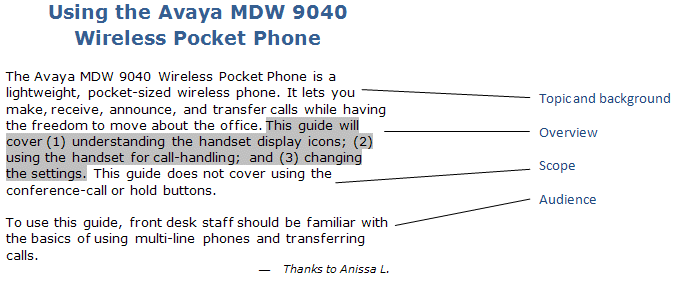The introduction is one of the most important sections of a report—or, for that matter, any document—but introductions are often poorly written. One reason may be that people misunderstand the purpose of introductions. An introduction introduces readers to the report and not necessarily, or only minimally, to the subject matter. "Introduction" does not equal "background"; it may contain some background but only minimally.
Readers have an understandable need to know some basic things about a report before they begin reading it: such as what is it about, why was it written, what's it for, for whom is it written, and what are its main contents. Readers need a basic orientation to the topic, purpose, situation, and contents of a report—in other words, an introduction.
Imagine that, years ago, you were writing a recommendation report about CD-ROM computer devices. You might be tempted to use the introduction to discuss the background of compact disc development or its theoretical side. That might be good stuff to include in the report, and it probably belongs in the report—but not in the introduction, or at least not in much detail or length.
For 10-page reports, introductions might average one half to one full page. On that one page, you might have three paragraphs. One of those paragraphs could be devoted to background information—in other words, to introducing the subject matter. But the other two paragraphs must do the job of introducing the report and orienting the reader to the report, as discussed in the following.
Be sure to check out the additional examples: introductions to instructions and reports.
Common Elements of Introductions
Note: If you are writing a brief 1- to 2-page document, be sure to read the following section on introductions to brief documents.
Each of the following elements is not required in all introductions, and some elements combine into the same sentence. Rather than mechanically applying these elements, write the introduction that seems good to you, then come back and search for these elements in it.
Topic. Early in the introduction, indicate the specific topic of the report. Some introductions seem to want to hold readers in suspense for a while before they indicate the true topic—that's a gamble. Better is to indicate the topic early—such that you could circle the topic words in the first three to four lines.
Purpose and situation. A good introduction needs to indicate why it was written, for whom, and for what purpose. If the report provides recommendations on whether to implement a program, the introduction needs to indicate that purpose. You might also consider indicating something of the scope of the report—what it is not intended to accomplish.
Audience. Indicate who are the appropriate or intended readers of the report—for example, "experienced technicians trained on the HAL/6000." Indicate what level of experience or knowledge readers need to understand the report, if any. If none is needed, say that. If the report was prepared for council members of the City of Utopia, Texas, the introduction needs to express that.
Overview of contents. Indicate the main contents of the report. You can do this with an in-sentence list, as the examples illustrate. If you are concerned about readers; exaggerated expectations, indicate what topics the report does not cover.
Background on the topic. This is everybody's favorite! Some minimal background is usually in an introduction—for example, key definitions, historical background, theory, the importance of the subject. Information like this gets readers interested, motivated to read, grounded in some fundamental concepts. Watch out, though—this discussion can get away from you and fill up more than a page. If it does, that's okay—all is not lost. Move it in to the body of the report, or into an appendix.
Background on the situation. Another kind of background is also a good candidate for introductions—the situation that brought about the need for the report. For example, if there were a lot of conflicting data about some new technology, which brought about the need for the research, this background could be summarized in the introduction. For example, if a company needed new equipment of some kind or if the company had some problem or need and some requirements in relation to that equipment—discussion of these matters should go in the introduction.
Notice in the discussion of these elements the word "indicate" keeps getting used. That's because you'd like to avoid heavy-handed language such as "The topic of this report is..." or "This report has been written for..." Notice how the example introductions generally avoid this kind of phrasing.
Example introduction to a lengthy report with contract elements included. (Opens as a popup; resize for better viewing.)
Example of another lengthy report introduction again, with contract elements included. (Opens as a popup; resize for better viewing.)
Grouping and Sequencing Elements in Introductions
Grouping. A common problem is to scatter background information in different parts of an introduction. While there may be good reasons for splitting up background information in disparate parts of an introduction, keeping it all in one place is usually best:

Disorganization in an introductory paragraph.
Notice the the red-highlighted sentence is background information. However, background information occurs in the first paragraph. Move it to the first paragraph, and rephrase it with "reliable" for transition.
Sequencing. Another way of analyzing introductions is to consider the sequence of information types occurring within them. With the out-of-place sentence moved to the first paragraph, a reasonable sequence of information types might be this:
|
Background information Topics to be covered Intended audience Scope: what's not ccvered |
Commonly used sequence of information types in an introductory paragraph.
Introductions to Brief Documents
Be sure to check out the additional examples: introductions to instructions and reports.
If you are writing a brief document of 1 to 2 pages, you don't need all those elements common to report introductions discussed in the preceding section. Here's the subset of what you are likely to need:
Topic. If you can circle the topic words somewhere in the first three to four lines of the introduction, you're good.
Purpose and situation. In instructions, it's enough to tell readers that they are going to see how to do something. In a recommendation report, just mention that readers will be seeing conclusions and recommendations.
Audience. Indicate what level of experience or knowledge readers need to understand the document. If none is needed, say that.
Overview of contents. Indicate the main contents of the document. A simple in-sentence list will do.
Background. Always remember that an introduction is not a background discussion; it may contain some, but only minimally.

Example of a brief introduction with most of the key elements present.
Introductions in Outlines
When you develop an outline for a report-length document, you may find yourself using that roman numeral I section for background information. Not a good idea. Remember the guideline: Introductions get readers ready to read the document. With that in mind, outlining the introduction to a report-length document is pretty easy. Here's an example:
I. INTRODUCTION
A. Purpose
B. Scope
C. Overview (brief list of what will be covered)
D. Situation and audience
II. BACKGROUND . . .
You need not include all of these elements nor in this exact order, and you should be able to deftly combine some of these elements in the same sentence.
Section Introductions
We don't normally think that there is more than one introduction in a report. However, in reports over 8 to 10 or more pages, the individual sections also need some sort of introduction. These can be called section introductions because they prepare readers to read a section of a report—they orient readers to its contents and purpose and show some linkage to the preceding section.
Of course, a section introduction need not have all the elements of a report introduction. However, it does have several that, if handled well, can make a lot of difference in the clarity and flow of a report.
 Example section introduction. Notice that this section introduction not only mentions the preceding and upcoming topics but shows how they are related. (From a report written in 1983.)
Example section introduction. Notice that this section introduction not only mentions the preceding and upcoming topics but shows how they are related. (From a report written in 1983.)
Topic indication. As with the report introduction, indicate the topic of the upcoming section. But remember—it doesn't have to be the stodgy, heavy-handed "The topic of this next section of the report is..."
Contents overview. Just as in the report introduction, it is a good idea to list the main contents. The in-sentence list serves this purpose well.
Transition. An element that is very useful in section introductions is transitional phrasing that indicates how the preceding section relates to the one about to start. In reports of any length and complexity, it is a good technique—it guides readers along, showing them how the parts of the report all fit together.
Revision Checklist for Introductions
As you revise your introductions, watch out for problems such as the following:
- Avoid writing an introduction consisting of only background information; avoid allowing background information to overwhelm the key elements of the introduction.
- Make sure to indicate the topic early.
- Be sure to indicate the audience and situation—what the readers should expect from the report; what knowledge or background they need to understand the report; what situation brought about the need for the report.
- Make sure there is an overview of the report contents, plus scope information—what the report doesn't cover.
I would appreciate your thoughts, reactions, criticism regarding this chapter: your response—David McMurrey.
